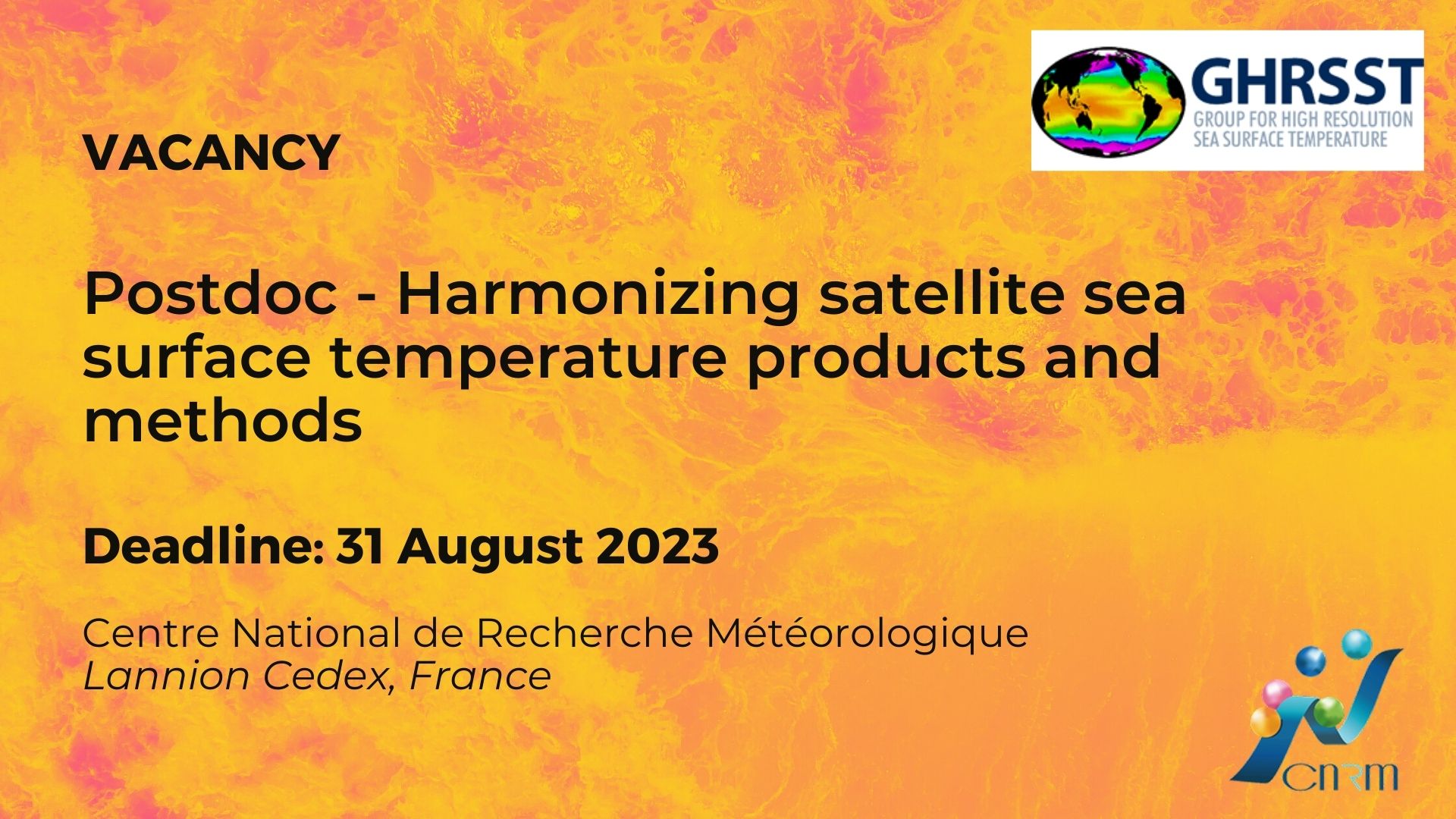Post-doctoral position in harmonizing satellite sea surface temperature products and methods.
Expected starting date: 1st October 2023
Duration: 18 months + 1 year possible extension
Context:
Sea Surface Temperature (SST) is an important property of the water surface of the Oceans, it
has numerous implications for physical and bio-geochemical processes at the air-sea interface. It is
also an important variable for climate monitoring. Remote sensing of SST is possible from satellite
observations since the 80’s with increasing quality and resolution. Nowadays a number of platforms
enable retrieval of SST with spatial resolution ranging from 3km to a few tenth of meters and a
frequency of observation up to 10 minutes for geostationary satellites.
EUMETSAT and the EUMETSAT Ocean and Sea-ice Satellite Application Facility (OSI SAF)
develop and deliver high quality SST products from the current EPS and MSG programmes as well
as from the Sentinel-3 SLSTR constellation.
The Group for High Resolution Sea Surface Temperature (GHRSST) gathers experts in the field
of SST retrieval together with users of those products. The GHRSST federates activities worldwide
and has published recommendations for SST data producers in order to facilitate SST data access
and usage for end-users. Further action can be taken to harmonize methodologies and scientific
meaning of the retrieved variables and associated meta-data.
The aim of the project Sci4MaST (Science for Marine Surface Temperature) is to develop day-2
SST and sea ice surface temperature for Sentinel-3 SLSTR. This project is therefore concerned by
the question of harmonizing SST data and in particular with the SST products distributed by the
OSI SAF. The post-doctoral position is offered in the framework of the Sci4MaST project.
Main duties:
The work expected can be divided into two main activities:
1- In the infrared spectral domain, the retrieved SST is sensitive to the skin surface temperature.
Some products such as the EUMETSAT SLSTR ones provide the skin SST (the algorithms being
trained on a simulated dataset), others such as the OSI SAF’s provide a so-called sub-skin SST
because the algorithms are established by using drifting buoy measurements at a depth of 20 to 30
cm. SST diurnal variability models enable the calculation of the temperature at any depth based on
environmental conditions (incoming solar energy at the surface, wind speed,…). Such a model is
being developed at EUMETSAT with the aim to be used for calculating SST at any depth and
therefore homogenized various SST products. The activity here will focus on the implementation,
test and validation of the model developed at EUMETSAT. Specific tasks include:
- Understand the model.
- Install and run the model on SST satellite data to estimate a depth temperature (at the depth
of drifting buoy measurements). - Compare depth temperature with drifting buoy measurements.
2- OSI SAF SST products from Metop and MSG and EUMETSAT SST products from Sentinel-3
have never been thoroughly compared in view of understanding their fundamental differences due
to their respective retrieval methodologies. Such an activity is important to define standards for
product harmonization. Specific tasks include:
- Acquire the scientific knowledge about SST retrieval from infrared sensors.
- Define and gather a working dataset of in-situ data, Metop, MSG and Sentinel-3 SST
products. - Define comparison metrics and methodologies.
- Perform the comparisons of the different products and analyse them with respect to a range
of variable such as the quality level.
Collaboration with the EUMETSAT Remote Sensing Product division is envisaged as well as with
the other Sci4MaST project partners and the GHRSST community.
The selected candidate will be expected to write reports and present their work at project meetings
and/or scientific conferences.
Workplace: Météo-France, avenue de Lorraine, BP 50747, 22307 Lannion Cedex, France. The
candidate will be assigned to the “Ocean” team within the Satellite Meteorology Research Center
(CEMS), research group of the Centre National de Recherche Météorologique (CNRM-UMR
3589 Météo-France / CNRS, http://www.umr-cnrm.fr/).
Salary: The gross monthly salary is between 2600 and 4000€ depending on experiences.
Qualifications and experience required: The candidate must hold a PhD in a scientific field
(Mathematics, Computer Science, Physics, …). Additional experience in a field related to
atmospheric sciences or geophysics would be appreciated. The candidate will master computer
languages (Fortran, Shell script, Python,…). The candidate will be fluent in English (read, spoken
and written).
Personal attributes: The candidate will have to demonstrate scientific curiosity, autonomy, team
spirit, responsiveness, analytical skills and scientific rigour in the interpretation of results. He/She
will have to be able to report periodically on his/her activities to the project team.
How to apply: Interested candidates should send, before the 31st of August 2023, the following
documents by e-mail only to Dr. Stéphane Saux Picart (stephane.sauxpicart@meteo.fr):
- Curriculum Vitae detailing relevant past experiences. A list of publications and
communications in conferences; - Application letter explaining research interests and motivation for the job;
- The names and contact details of two referees (recommendation letters shall be appreciated
but are not mandatory)

